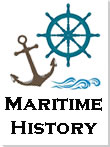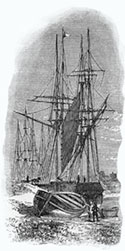Maritime History of Newport
By Peter Brown
© Peter Brown 2024
The eighteenth century
The 18th century saw the commencement of regular sailings to Bristol and the development of two new wharves in Newport, the Tredegar Wharf, north of the Medieval wharf area, and the Moderator Wharf on the area formerly occupied by the Waterside Key.
In his 1847 book on the history of Newport, Scott states that the Tredegar family promoted better trade with Bristol around 1700 by providing a smack of about 40 tons named the Tredegar Boat for a regular service.[1] About 1722, the Tredegar market boat left for Bristol during Christmas week, carrying corn, poultry, and many passengers. At the mouth of the Usk the ship foundered, sinking so that the deck was covered. Rescue ships saved many people, but 36 lives were lost.
The name Moderator was associated with one of the town quays where the Riverfront Theatre now stands and was named by the shipowner Mr Kemys, who capitalised on the exorbitant fees charged for shipping between Newport and Bristol. He decided to capture this market by placing on station a boat that he named the Moderator, charging only moderate prices for transport. The wharf from which this boat sailed was henceforth known as the Moderator Wharf, a name that survived into the 20th century.[2] Other improvements were made to the wharfage in Newport during the 18th century, and a wharf on the southern side of the Town Pill was mentioned in 1723.[3]
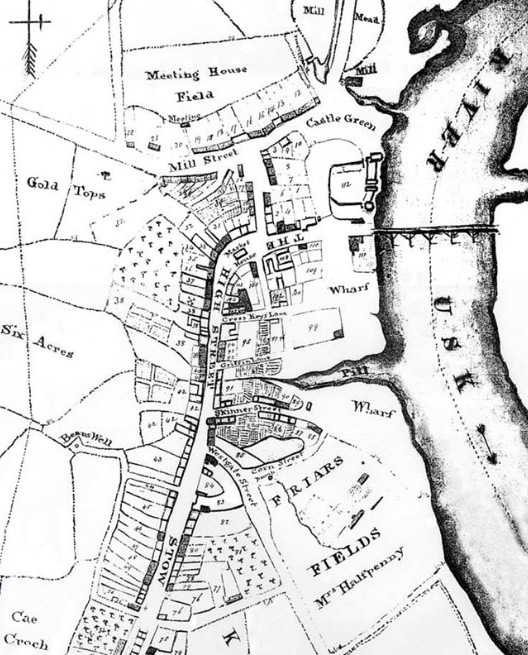
Detail from the 1750 plan of Newport, showing the wharf areas and the Town Pill reaching towards High Street.
The writer Daniel Defoe toured England and Wales in the 1720s and wrote about his travels in Monmouthshire:[4]
Lower down upon the Wye stands Chepstow, the sea port for all the towns seated on the Wye and Lug, and where their commerce seems to center. Here is a noble bridge over the Wye: To this town ships of good burthen may come up, and the tide runs here with the same impetuous current as at Bristol; the flood rising from six fathom, to six and a half at Chepstow Bridge. This is a place of very good trade, as is also Newport, a town of the like import upon the River Uske, a great river, tho' not so big as Wye, which runs thro' the center of the county, and falls also into the Severn Sea.
This county furnishes great quantities of corn for exportation, and the Bristol merchants frequently load ships here, to go to Portugal, and other foreign countries with wheat; considering the mountainous part of the west of this county, 'tis much they should have such good corn, and so much of it to spare; but the eastern side of the county, and the neighbourhood of Herefordshire, supplies them.
The Cardiff Customs House records for 1729 mention goods carried coastwise from Caerleon, but state that “The ancient capital of Siluria still possesses a couple of deserted wharves and ruinous warehouses, but it is probably many years since a sea-going vessel hailed from that creek.”[5]
A painting by Thomas Cooke in 1785 shows a ship at the quay in Caerleon near the Hanbury Arms at the start of industrialisation when a tramway connected to the quay. The timber bridge was replaced by the existing stone bridge completed in 1812, roughly 100 metres downstream and close to the viewer.
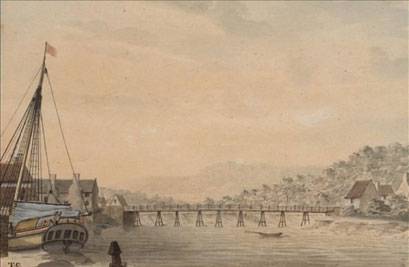
Caerleon Bridge and Wharf.
Watercolour by Thomas Cooke, 1785
In the collection of Newport Musem and Art Gallery.
The late 1740s saw a long-running dispute between Mr Burgh and the Earl of Powis over the Town Green and the Castle Garden.[6] During the dispute, Colonel Morgan, the Earl’s tenant, used stone from the castle to build a quay on the Green. In the following year, Burgh made a survey of his property, claiming that Morgan had:
built a quay and taken wharfage and anchorage without acknowledgement. The storehouse had been pulled down and stones used as a slip.
In 1764, the Customs Collector appointed a commission to determine the places where quays and wharves were to be constructed on the Usk. His suggested members were Thomas Morgan, junr. of Ruperra, Morgan Lewis of St. Peers, Charles Vann of Caerleon, Harry Morgan of Caerleon, William Seys of Newport, Francis Davis of Chepstow and Llewellin Treherne of Cardiff.[7]
Also in 1764, Mr William Kemys requested permission to land and ship goods on a wharf or quay to be erected by him “within the Castle of Newport.”[8] The petition noted that most trade was with Bristol, except for two or three loads of oak bark every year for Ireland, and for about 40 years, the only goods returning were a few dozen calf skins. Concerns were expressed that Kemys could obstruct access to the quay from either side, and it was also noted that the castle was above the bridge, so ships would have to lower their masts to access the quay. It was noted that the three “old keys or wharfs” belonged to General Morgan of Tredegar and that one of them “hath been erected time out of mind.” Kemys’s motives were questioned for the apparent desire to draw trade from elsewhere.
In 1794, the Mayor and alderman assumed fuller control over the power of the burgesses. Their first step was to recover part of the Town Green from the Duke of Beaufort, who had erected upon it a quay, wall and wharf at the considerable expense of £5,046 12s. for the masonry, timber, haulage, etc.[9] From 1799-1805, the water bailiff collected the wharfage and keelage. The Corporation regarded the Town Green as their property and did not consult the burgesses before accepting the Canal Company’s offer to pay £56 for land used to make a slip and bridge to the Town Wharves and to level the Green on the west side of the canal.[10] The dispute between the Corporation and the burgesses over rights and income from the “Corporation wharf” continued for several decades and involved John Frost in 1821.[11]
The late 18th century also saw the Mayor increase his control by the appointment of two water bailiffs, whose duties were “to regulate the berths and moorings of vessels, to prevent the unloading of ballast in the river, to exercise general superintendence over the port and river and to collect rents and dues.” In 1810, the second water bailiff was appointed to oversee the Pillgwenlly district.[12]
A town plan made in 1794 shows the riverside just before the canal reached the town two years later. No quays are shown, but two ‘slips’ refer to slipways down to ships. The Moderator slip was located where the Riverfront Theatre stands today, with the Tredegar slip closer to the town bridge. Remains found in 2002 when the Newport ship was excavated were probably traces of the Moderator slip shown on the plan.[13]
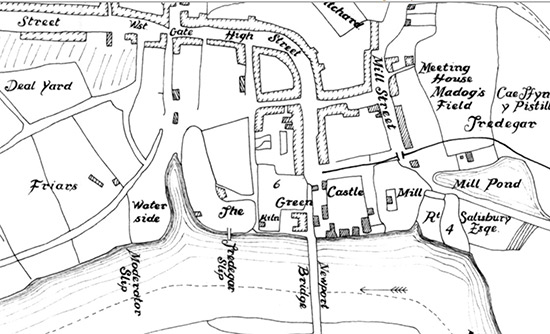
1794 plan of Newport showing the Moderator and Tredegar slips.[14]
Trade
The port records suggest that the earlier part of the 18th century saw a decline in Usk shipping, although trade with Bristol continued on a more limited basis. However, the Bristol port books provide some very detailed records from 1700, when, on 31 January, the Ann and Mary sailed for Newport under master and merchant William Walters. The mixed cargo is one of the earliest extensive and detailed inventories that we have, illustrating the range of products traded at that time:[15]
- forty bends thirteen bundles of leather
- three hundred weight iron and cutlery wares
- one basket tynne wares
- four baskets leather wares
- one box glass, two tons grocery, four hampers hopps, one ton sope, two half barrells pitch, fourteene cases brandy and strong waters
- four reames paper, two barrells herrings
- fifteen packs, eight trusses, thirteene boxes, six trunks of linen, woollen, mercery, drapery, dashershery
- one trunke wearing apparel
- one hamper Spanish wine and one runlet; three h’hds, one pack, eleaven trusses, three caskes, three bags, four roles, three boxes, one bundle, one paper pcll of tobacco, qt two seven hund and seventy pounds
On the same day, the Seaflower of “Carlyon” sailed for home under “Philip Gwinne Master and merchant" with a cargo of wool. The Carlyon Merchant sailed the same day under Phil Gwynne with a similar mixed cargo to the Ann and Mary above.[16]
The Seaflower sailed again on 4 February under William Gwin, carrying the following mixed cargo:[17]
Fifty bends, four packs leather, twoe tons tobacco pipe clay, one runlet strong waters, five hundredweight sope, two hogsheads, three runlets (small barrels of 1/14 of a tun), train (whale) oyle, six barrells herrings, nine packs and trusses lynnen woolen and mercery, five hundwt pitch and rozin, twoe tons grocery and saltery, and dyeing stuffs, three bundles flax, three baskets Spanish wine, twoe hundredweight iron ore, seven hogsheads, eleven parcels, two trusses, twoe bags, twoe kilderkins, twoe boxes tobacco qt four thousand twoe hundred and sixty pounds, five cases glass.
For a period at the start of the century, the Seaflower, the Ann and Mary and the Carlyon Merchant seem to have continued the Bristol trade, as their predecessor Usk ships had done throughout the 17th century.
The records for the port of Cardiff (which included Newport) indicate a decline in shipping as the 18th century progressed, with some of the exports listing oak bark for Ireland.[18] Newport was mentioned on 21 July 1747, when the Happy Return of Newport (25 tons) with 80 tons of oak bark and 60 oak planks cleared for Ireland.[19] Newport ships continued with the Irish trade, with the Hopewell (30 tons) sailing for Newry with “6 tons of pit coal (duty 8d. per ton), 15 tons oak bark, 200 bundles rhyne hoops, 45 cheeses yts 4 cwt. duty free.” The Betsy of Newport (30 tons) took 14 tons of oak bark to Kinsale in 1757, 7 tons of oak bark and 10 hogsheads of cider to Kinsale in 1758. The Hopewell sailed for Cork in 1758 carrying “6 tons of pit coal, 300 feet oak plank, 20 tons oak bark, 21 boxes tin plates, 4 bundles iron plates.” The tin plates were probably made at Pontypool by the Hanburys, who had perfected the art of rolling plates for tinning at the century's start.[20] Together with the Endeavour and Moderator, these vessels carried wool and iron to Bristol, Gloucester, Bridgwater and other channel ports in 1763.[21]
A feature of the middle of the 18th century was the trade in iron from the Bar Iron Warehouse in Newport supplied by the forges at Bassaleg and Machen. The accounts give some idea of the volume of this trade for 1756, where the iron shipped to Bristol was 202 tons, Bewdley 17 and Gloucester 6. The trade with Bristol had increased to 318 tons by 1760, when Bridgwater was also a destination.[22]
In 1767, the landholders and farmers in the Newport and Caerleon area petitioned the Lords Commissioners of HM Treasury regarding the vessels trading from these places to Bristol. They asked that the vessels be cleared out without challenge by other ships (known as Letpass), and not by Cocket, which involved a bond confirming that the goods had been registered for customs.[23] The argument for this was that they were only crossing a river, not the open sea, and because from time immemorial, the Holm islands (Flat Holm and Steep Holm) had been regarded as the junction of the Severn and the Bristol Channel. Despite this, the Collector declined the request because ships on this route could transfer cargo to other ships.[24]
An advert in the Bristol Gazette and Public Advertiser in 1779 notified the sale of the Tredegar and Machen Ironworks, located six miles from Newport, where “there is a market boat trading every week.”[25] Browne’s Bristol Directory for 1785 listed the coasters to and from Bristol, which included the Caerleon of Caerleon, and the Moderator, the Tredegar and the Speedwell of Newport. Every week, the ships were entered ‘inwards’ at Bristol on Wednesday and ‘outwards’ on Thursday.[26]
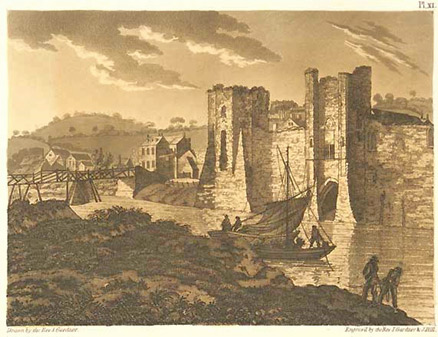
Castle, wooden bridge and town, Newport. The lowered mast can be seen on one of the trows.
By John Gardnor, published in The History of Monmouthshire by David Williams, 1793.
By 1792, foreign trade was increasing and two Norwegian vessels arrived carrying timber. There was still no ‘lawful’ quay, but Newport had an advantage over Cardiff due to the tidal flow and lesser problem with mud. With the development of the local coal mines, Newport was shipping out around 266 tons per year, but that had increased fourfold by the end of the century, mainly due to the opening of the Monmouthshire Canal to Newport in 1796. This was the start of the industrialisation that transformed Newport into a significant port in the following century.[27]
Ships
The registration of shipping became compulsory in 1786, and vessels belonging to Newport in the late 18th century included the brig Good Intent, the sloops Tredegar, Friendship, Three Friends, Providence, Frederick and Thirza and Moderator. Caerleon sloops were Carlion, Betsey and Five Brothers. The Tredegar was described as a sloop of 62⅔ tons with standing bowsprit, built in 1787 and owned by Thomas Powell and William George.[28]
We know that Abraham Jones was the master of the Moderator in 1792 when Robert Gething was the master of the Caerleon.[29] Three years later, Captain Belcher commanded the Tredegar. Caerleon supplied another ship for this traffic in 1797 when the Iron and Tin Trader started a weekly service for the tinplate works at Ponthir, owned by the Jenkins family. They also owned the Carlion in 1806, described as carrying 62 tons.[30]
References
1 Scott, J. M. (1847) The ancient and modern history of Newport, Monmouthshire, 57-9.
Online at: https://play.google.com/books/reader?id=6fDBCw31psEC&pg=GBS.PP1&hl=en
2 Newport Past website: http://www.newportpast.com/nfs/y00t29/y1805.htm
3 Maylan C. N. (1991) Proposed Usk Barrage Initial Archaeological Assessment, GGAT Report No. 91/01, 12, citing Gwent Archives D.43.3321
Online at: https://walesher1974.org/her/app/php/herumd.php?level=2&group=GGAT&docid=301464088&linktable=her_source1_link
4 Defoe, Daniel (1724-27) Tour Through the Whole Island of Great Britain.
Online at: https://www.visionofbritain.org.uk/travellers/Defoe/23
5 Custom House Records: Introduction, Pages 363-367, Cardiff Records: Volume 2. Originally published by Cardiff Records Committee, Cardiff, 1900.
Online at: https://www.british-history.ac.uk/cardiff-records/vol2/pp363-367
6 Jones, Brynmor Pierce (1957) From Elizabeth I to Victoria: The Government of Newport (Mon.) 1550-1850, Newport: Newport Corporation, 112.
7 Dawson, J. W. (1932) Commerce and Customs: A History of the Ports of Newport and Caerleon, 44.
Online at: https://archive.org/details/commerce-and-customs-newport
8 Dawson, 45-6.
9 Jones, 1957, 75, citing NLW Tred. MSS. Pt. 2, Box 67, no. 412.
10 Jones, 1957, 75, citing Corporation Minute Book, December 1808.
11 Jones, 1957, 98-100, citing CRD. W. 4.601 Letter to Thomas Prothero, 1821.
12 Jones, 1957.
13 Trett, Bob (2007) The Newport Medieval Ship.
Online at: http://www.newportpast.com/early/port/ship.htm
14 http://www.newportpast.com/gallery/maps/1794/index.php
15 Dawson, 39.
16 Dawson, 39.
17 Dawson, 40.
18 Dawson, 40.
19 Dawson, 41.
20 https://biography.wales/article/s-HANB-URY-1664
21 Dawson, 41.
22 Dawson, 41-3.
23 Dawson, 44.
24 Dawson, 45.
25 Dawson, 47.
26 Dawson, 47.
27 Dawson, 48.
28 Dawson, 100.
29 Dawson, 47.
30 Kennerley, E. (1979) ‘River Trade and Shipping in Caerleon from the 16th to the 19th Century’, Gwent Local History, 47.
Online at: http://www.caerleon.net/archive/literature/glh/47river.htm , citing Bristol Water bailiff's Fees and Emoluments, Bristol R.O.
Back to Index of Peter Brown's "Maritime History of Newport "
